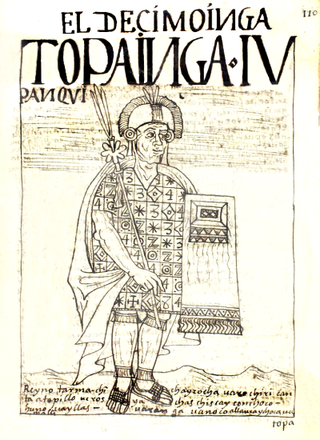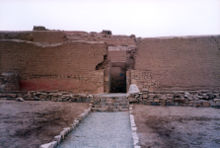
The Inca Empire, called Tawantinsuyu by its subjects, was the largest empire in pre-Columbian America. The administrative, political, and military center of the empire was in the city of Cusco. The Inca civilization rose from the Peruvian highlands sometime in the early 13th century. The Spanish began the conquest of the Inca Empire in 1532 and by 1572, the last Inca state was fully conquered.

Túpac Amaru was the last Sapa Inca of the Neo-Inca State, the final remaining independent part of the Inca Empire. He was executed by the Spanish following a months-long pursuit after the fall of the Neo-Inca State.

Manco Cápac, also known as Manco Inca and Ayar Manco, was, according to some historians, the first governor and founder of the Inca civilization in Cusco, possibly in the early 13th century. He is also a main figure of Inca mythology, being the protagonist of the two best known legends about the origin of the Inca, both of them connecting him to the foundation of Cusco. His main wife was his older sister, Mama Uqllu, also the mother of his son and successor Sinchi Ruq'a. Even though his figure is mentioned in several chronicles, his actual existence remains uncertain.
Pachacámac is an archaeological site 40 kilometres (25 mi) southeast of Lima, Peru in the Valley of the Lurín River. The site was first settled around A.D. 200 and was named after the "Earth Maker" creator god Pacha Kamaq. The site flourished for about 1,300 years until the Spanish invaded. Pachacamac covers about 600 hectares of land.
In Inca mythology, Vichama is the god of death and the son of Inti. His mother was murdered by his half-brother Pacha Kamaq, and he took revenge by turning the humans who were created by Pachacamac into rocks and islands. Afterwards he hatched three eggs from which a new race of humans was born.

Sinchi Roca, Sinchi Rocca, Cinchi Roca, Sinchi Ruq'a or Sinchi Ruq'a Inka was the second Sapa Inca of the Kingdom of Cusco and a member of the Hurin dynasty.

The Inca religion was a group of beliefs and rites that were related to a mythological system evolving from pre-Inca times to Inca Empire. Faith in the Tawantinsuyu was manifested in every aspect of his life, work, festivities, ceremonies, etc. They were polytheists and there were local, regional and pan-regional divinities.

Topa Inca Yupanqui or Túpac Inca Yupanqui, also Topa Inga Yupangui, translated as "noble Inca accountant," was the tenth Sapa Inca (1471–93) of the Inca Empire, fifth of the Hanan dynasty. His father was Pachacuti, and his son was Huayna Capac. Topa Inca belonged to the Qhapaq panaca. His qoya was his older sister, Mama Ocllo.

Inti is the ancient Inca sun god. He is revered as the national patron of the Inca state. Although most consider Inti the sun god, he is more appropriately viewed as a cluster of solar aspects, since the Inca divided his identity according to the stages of the sun. Worshiped as a patron deity of the Inca Empire, Pachacuti is often linked to the origin and expansion of the Inca Sun Cult. The most common belief was that Inti was born of Viracocha, who had many titles, chief among them being the God of Creation.
Q'ero is a Quechua-speaking community or ethnic group dwelling in the province of Paucartambo, in the Cusco Region of Peru.

The Kingdom of Cusco, also called the Cusco confederation, was a small kingdom based in the Andean city of Cusco that began as a small city-state founded by the Incas around the start of 13th century. In time, through warfare or peaceful assimilation, it began to grow and was succeeded by the Inca Empire (1438–1533).
In Pre-Incan mythology, Kón (Con) was the god of rain and wind that came from the North. He is thought to be a deity to the Paracas Civilization, who was later adopted into Nazca and Incan mythology through different names. He was a son of Inti and Mama Killa.

The Lima culture was an indigenous civilization which existed in modern-day Lima, Peru during the Early Intermediate Period, extending from roughly 100 to 650. This pre-Incan culture, which overlaps with surrounding Paracas, Moche, and Nasca civilizations, was located in the desert coastal strip of Peru in the Chillon, Rimac and Lurin River valleys. It can be difficult to differentiate the Lima culture from surrounding cultures due to both its physical proximity to other, and better documented cultures, in Coastal Peru, and because it is chronologically very close, if not over lapped, by these other cultures as well. These factors all help contribute to the obscurity of the Lima culture, of which much information is still left to be learned.

Inca mythology is the universe of legends and collective memory of the Inca civilization, which took place in the current territories of Colombia, Ecuador, Peru, Bolivia, Chile, and Argentina, incorporating in the first instance, systematically, the territories of the central highlands of Peru to the north.

Pachamama is a goddess revered by the indigenous peoples of the Andes. In Inca mythology she is an "Earth Mother" type goddess, and a fertility goddess who presides over planting and harvesting, embodies the mountains, and causes earthquakes. She is also an ever-present and independent deity who has her own creative power to sustain life on this earth. Her shrines are hallowed rocks, or the boles of legendary trees, and her artists envision her as an adult female bearing harvests of potatoes or coca leaves. The four cosmological Quechua principles – Water, Earth, Sun, and Moon – claim Pachamama as their prime origin. Priests sacrifice offerings of llamas, cuy, and elaborate, miniature, burned garments to her. Pachamama is the mother of Inti the sun god, and Mama Killa the moon goddess. Mama Killa is said to be the wife of Inti.

Yanaca is a group of ancient, pre-Incan towns located in Peru in Apurimac Region, Aymaraes Province, Yanaca District. These towns were located in the area surrounding the present-day town of Yanaca in the Andes mountain range, between the Quechua and Suni regions.

The Ichma kingdom or Pachacamac kingdom was a pre-Inca indigenous polity later absorbed by the Inca Empire and reorganized as a wanami (province). For the Inca it was known as Pachakamaq (Pachacamac), rather than its original name of Ishma.

The pacha was an Incan concept for dividing the different spheres of the cosmos in Incan mythology. There were three different levels of pacha: the hana pacha, hanan pacha or hanaq pacha, ukhu pacha, and kay pacha. The realms are not solely spatial, but were simultaneously spatial and temporal. Although the universe was considered a unified system within Incan cosmology, the division between the worlds was part of the dualism prominent in Incan beliefs, known as Yanantin. This dualism found that everything which existed had both features of any feature.
Mama Quilla, in Inca mythology and religion, was the third power and goddess of the moon. She was the older sister and wife of Inti, daughter of Viracocha and mother of Manco Cápac and Mama Uqllu (Mama Ocllo), mythical founders of the Inca empire and culture. She was the goddess of marriage and the menstrual cycle, and considered a defender of women. She was also important for the Inca calendar.













